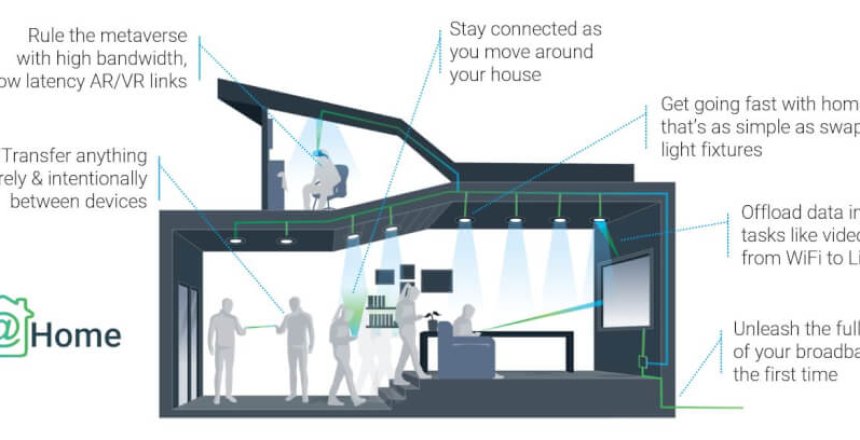Wi-Fi has a lot of issues when it comes to range and hard surfaces. If you extend the range using Wi-Fi range extenders you half the speed of your internet connection with each extender you use. Or you run multiple wireless networks in your property and it’s a huge problem, so Li-Fi might be your solution.
What is Li-Fi?
Li-Fi as a standard has been around for as long as Wi-Fi has been around, starting in 1997 and has been a niche product for certain markets for some time, however in July 2022, there has been a new standard ratified called 802.11bb that supports considerably faster speeds using light instead of radio waves.
A small optical transceiver can be placed inside an LED downlighter that can send and receive data from any device in the same room at Gigabit speeds, with far less latency than Wi-Fi and since each room or each light fitting is independent, there is no problem with signal interference.
There is a huge advantage of optical over radio frequencies in terms of band usage, as the Wi-Fi market has to keep finding space in the crowded frequencies to get better performance, the optical band lacks the interference. There are disadvantages, in terms of sunlight which makes Li-Fi impractical for outdoor operation.
How does it work?
Consider the remote control for your TV, you point it at the set and press a button and the TV responds to your request. Li-Fi works in a similar way.
However, if someone is standing in the way of the TV, then you can’t control the TV with the remote.
Li-Fi has been working on a solution to that problem, by developing the technology to work from LED downlighters. LED downlighters are not used alone to provide light in a room, they are often used in a cluster, and this technology can be used to provide a cluster of communication sources that don’t interfere with each other.
Since the light is shone downwards from the ceiling, the amount of blockages are considerably reduced. This means that provided the devices have access to the lighting and can function properly.
What are the use cases of Li-Fi?
The use case for this technology is in the home, as it can be used instead of Wi-Fi or to complement it.
Pure LiFi is the company that invented the technology has use cases in the home. Since the networking cable runs in the ceiling, it’s not visible to the user.
Smart home – Devices in the home that communicate together, such as thermostats and media systems.
Direct communication – Since there is no need for devices to connect to a network to share information it can be beamed from one device to another, without the need for the Internet.
VR and AR – Li-Fi works with very low latency, which is great for streaming games and content to wearable devices without affecting other devices on the network.
Media and Game Streaming – Another advantage of low latency is that media and games can be streamed easily to make watching content and playing games a more seamless experience.
Professor Harald Haas' video
Back in 2011, Professor Harald Haas presented to the TED talks, and below is his video where he demonstrates Li-Fi technology.

